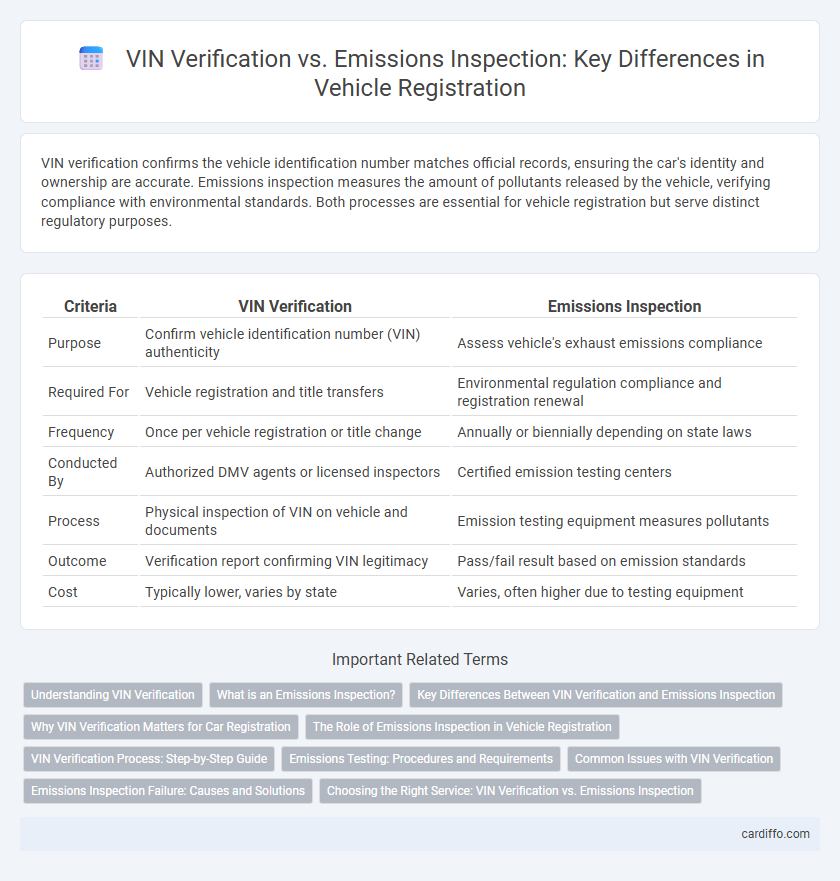VIN verification confirms the vehicle identification number matches official records, ensuring the car's identity and ownership are accurate. Emissions inspection measures the amount of pollutants released by the vehicle, verifying compliance with environmental standards. Both processes are essential for vehicle registration but serve distinct regulatory purposes.
Table of Comparison
| Criteria | VIN Verification | Emissions Inspection |
|---|---|---|
| Purpose | Confirm vehicle identification number (VIN) authenticity | Assess vehicle's exhaust emissions compliance |
| Required For | Vehicle registration and title transfers | Environmental regulation compliance and registration renewal |
| Frequency | Once per vehicle registration or title change | Annually or biennially depending on state laws |
| Conducted By | Authorized DMV agents or licensed inspectors | Certified emission testing centers |
| Process | Physical inspection of VIN on vehicle and documents | Emission testing equipment measures pollutants |
| Outcome | Verification report confirming VIN legitimacy | Pass/fail result based on emission standards |
| Cost | Typically lower, varies by state | Varies, often higher due to testing equipment |
Understanding VIN Verification
VIN verification confirms a vehicle's unique identification number to ensure it matches official records, preventing fraud and discrepancies during registration. This process involves a physical inspection of the VIN plate by authorized personnel to validate its authenticity and accuracy. Unlike emissions inspection, which assesses environmental compliance, VIN verification strictly focuses on confirming vehicle identity for legal registration purposes.
What is an Emissions Inspection?
An emissions inspection is a state-mandated test designed to measure the amount of pollutants emitted from a vehicle's exhaust system, ensuring compliance with environmental standards. This inspection typically evaluates harmful gases such as carbon monoxide, hydrocarbons, and nitrogen oxides to reduce air pollution and promote public health. Unlike VIN verification, which confirms vehicle identification numbers, emissions inspections specifically target the environmental impact of a vehicle's operation.
Key Differences Between VIN Verification and Emissions Inspection
VIN verification confirms a vehicle's identity by matching its Vehicle Identification Number to official records, ensuring the car is legally registered. Emissions inspection evaluates a vehicle's exhaust to determine if it meets environmental standards, focusing on pollution control and air quality compliance. The primary difference lies in VIN verification's role in legal identification, whereas emissions inspection centers on environmental impact and regulatory adherence.
Why VIN Verification Matters for Car Registration
VIN verification ensures the vehicle's identity matches official records, preventing fraud and confirming ownership during car registration. Accurate VIN validation is essential to comply with state regulations and avoid legal issues when transferring or titling a vehicle. This process also supports proper tracking of a car's history, crucial for registration approval and maintaining road safety standards.
The Role of Emissions Inspection in Vehicle Registration
Emissions inspection plays a critical role in vehicle registration by ensuring that vehicles meet environmental standards set by regulatory agencies. This inspection helps reduce air pollution and supports public health initiatives by verifying that a vehicle's exhaust emissions comply with state and federal requirements. Unlike VIN verification, which confirms the vehicle's identity, emissions inspection directly addresses environmental compliance essential for legal registration approval.
VIN Verification Process: Step-by-Step Guide
The VIN verification process involves visually inspecting the vehicle identification number on the dashboard and comparing it with the registration documents to confirm authenticity and accuracy. Technicians cross-check the VIN against state databases to ensure no discrepancies or signs of tampering exist during this step. Completing these verification steps accurately is essential to prevent registration delays and maintain compliance with state vehicle regulations.
Emissions Testing: Procedures and Requirements
Emissions testing involves measuring the levels of pollutants released from a vehicle's exhaust to ensure compliance with environmental standards set by regulatory agencies such as the EPA or state environmental departments. The procedure typically requires connecting the vehicle to a dynamometer or performing an onboard diagnostic (OBD) test to assess emissions during various operating conditions. Compliance with emissions requirements is mandatory for vehicle registration renewal in many states, aiming to reduce air pollution and promote environmental health.
Common Issues with VIN Verification
VIN verification often encounters issues such as mismatched or illegible VIN numbers due to wear, tampering, or errors in documentation. Inaccurate or incomplete VIN records can delay vehicle registration and require re-inspection, causing administrative challenges for both vehicle owners and authorities. Ensuring the physical VIN on the vehicle matches the official paperwork is critical to avoid common roadblocks in the registration process.
Emissions Inspection Failure: Causes and Solutions
Emissions inspection failure often results from issues such as faulty oxygen sensors, malfunctioning catalytic converters, or clogged air filters that increase harmful pollutants beyond legal limits. Addressing these causes involves repairing or replacing defective components, performing engine tune-ups, and ensuring the vehicle's onboard diagnostics system is fully operational. Regular maintenance and prompt repairs improve emissions compliance, preventing registration delays related to failed inspections.
Choosing the Right Service: VIN Verification vs. Emissions Inspection
Choosing the right service between VIN verification and emissions inspection depends on your specific registration requirements and state regulations. VIN verification confirms the vehicle's identity and ensures its details match official records, which is essential for title transfers and registering out-of-state vehicles. Emissions inspection assesses a vehicle's pollution levels to comply with environmental standards, often required for renewal in areas with strict air quality regulations.
VIN Verification vs Emissions Inspection Infographic

 cardiffo.com
cardiffo.com